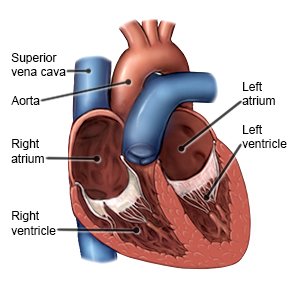Aortic Balloon Valvuloplasty
Medically reviewed by Drugs.com. Last updated on Sep 23, 2025.
WHAT YOU NEED TO KNOW:
Aortic balloon valvuloplasty is a procedure to open your aortic valve. This allows blood to flow more easily through your heart. The aortic valve is the door between the left ventricle and the aorta.
 |
HOW TO PREPARE:
The week before your procedure:
- Tell your healthcare provider about all medicines you currently take. Your provider will tell you if you need to stop taking any medicine before your procedure, and when to stop. Tell him or her if you have had an allergic reaction to any medicine.
- You may need blood tests before your procedure.
- Contrast liquid may be injected into the catheter during your procedure. Contrast liquid helps to make arteries, heart chambers, and the valve easier for healthcare providers to see. Tell your provider if you have ever had an allergic reaction to contrast liquid.
The night before your procedure:
You may be told not to eat or drink anything after midnight.
The day of your procedure:
- You or a close family member will be asked to sign a legal document called a consent form. It gives healthcare providers permission to do the procedure or surgery. It also explains the problems that may happen, and your choices. Make sure all your questions are answered before you sign this form.
- Take only the medicines your healthcare provider told you to take.
- Healthcare providers may put an IV into your vein. You may be given liquids and medicine through the IV.
- An anesthesiologist will talk to you before your surgery. You may need medicine to keep you asleep or numb an area of your body during surgery. Tell healthcare providers if you or anyone in your family has had a problem with anesthesia in the past.
WHAT WILL HAPPEN:
What will happen:
You will be given medicine in your IV to help you relax or make you drowsy. Local anesthesia will be used to numb your groin. You may still feel pressure or pushing during the procedure. A catheter with a balloon on the tip will be inserted into an artery in your groin and threaded into your heart. You may have a fluttering feeling in your chest. This is caused by extra heartbeats when the catheter is in your heart. When the end of the catheter is in the aortic valve, the balloon will be filled with liquid. This forces the valve to open so blood can flow more freely.
After the procedure:
You will be taken to a room to rest until you are fully awake. Healthcare providers will monitor you closely for any problems. A bandage will cover the area where the catheter went in. The bandage puts pressure on your groin to prevent bleeding. A healthcare provider will check for bleeding or bruising. Do not get out of bed until your healthcare provider says it is okay. When your healthcare provider sees that you are okay, you will be taken to your hospital room.
CONTACT YOUR HEALTHCARE PROVIDER IF:
- You have a fever.
- You have questions or concerns about the procedure.
Risks
- You may bleed more than usual, develop an infection, or have trouble breathing. The artery in your groin may be damaged. The other valves or muscles in your heart could be damaged. You may have a stroke or heart attack if air bubbles or pieces of calcium from the valve go into your bloodstream. Your kidneys may stop working. You could have problems with your heartbeat. You may get a blood clot in your leg or arm. This may become life-threatening.
- Even after this procedure, your aortic valve may grow narrow again over time. If this happens, you may need to have the procedure again or have heart surgery.
Related medications
Care Agreement
You have the right to help plan your care. Learn about your health condition and how it may be treated. Discuss treatment options with your healthcare providers to decide what care you want to receive. You always have the right to refuse treatment.© Copyright Merative 2025 Information is for End User's use only and may not be sold, redistributed or otherwise used for commercial purposes.
The above information is an educational aid only. It is not intended as medical advice for individual conditions or treatments. Talk to your doctor, nurse or pharmacist before following any medical regimen to see if it is safe and effective for you.
Further information
Always consult your healthcare provider to ensure the information displayed on this page applies to your personal circumstances.
